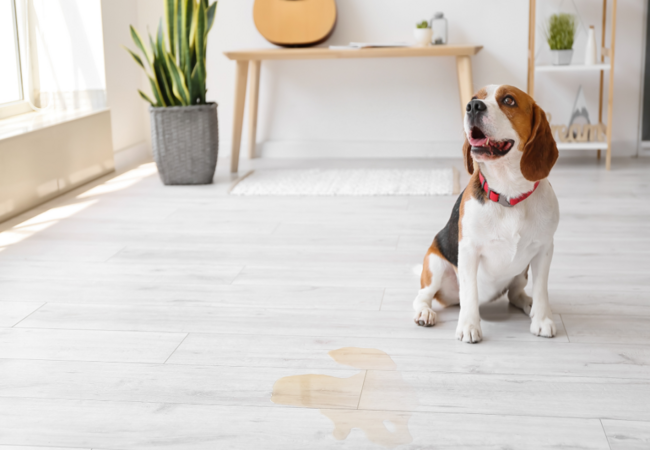2025 Vet Guide: Dog Peeing in the House—Medical vs Behavioral Causes & Solutions 🐶🚽

In this article
2025 Vet Guide: Dog Peeing in the House—Medical vs Behavioral Causes & Solutions 🐶🚽
By Dr. Duncan Houston BVSc
Accidents from a fully house‑trained dog can be frustrating and worrying. When an adult dog starts peeing indoors, it’s crucial to discern whether the cause is medical or behavioral and treat it appropriately. This guide will equip you to address the issue confidently.
⚠️ 1. When to See Your Vet Immediately
Schedule a veterinary visit if accidents are paired with any of the following:
- Blood in urine, straining to urinate, or urinating tiny volumes
- Increased drinking, vomiting, lethargy, and appetite changes
- Pus, fever, swelling, or pain during urination
🧪 2. Common Medical Causes
- Urinary Tract Infections or Cystitis: Frequent, painful urination with possible blood or odour
- Bladder stones or tumors: May cause frequent attempts, straining, or blood
- Diabetes or Kidney Disease: Large volumes of urine, increased thirst
- Cushing’s Disease: Similar signs plus panting, pot belly
- Incontinence (USMI): Especially in spayed females—leakage when resting or excited
- Cognitive Dysfunction: In older dogs, forgetfulness leads to inappropriate urination
🧠 3. Behavioral & Environmental Factors
- Submissive or Excitement Urination: Often small puddles during greetings or with new people
- Territorial Marking: Frequent small spots on walls, furniture—common in intact dogs
- Stress or Anxiety: During storms, new routines, a new home, or household changes
- House-training Lapse: Changes in routine or environment may cause confusion
- Weather Avoidance: Dogs may refuse to go outside in rain, cold, or heat
- Arthritis or Mobility Issues: Older dogs may struggle to move outdoors in time
🔬 4. Veterinary Diagnostic Approach
- Urinalysis and urine culture to check for infections, blood, and crystals
- Blood tests to assess organ function and endocrine disorders
- Imaging (X-rays/ultrasound) to locate bladder stones or masses
- Neurologic/behavioral evaluation for cognitive decline or anxiety-related causes
🛠️ 5. Treatment & Management Strategies
Medical Cases
- UTIs or stones: appropriate antibiotics or surgical intervention
- Hormonal conditions: specialized medications for diabetes, Cushing’s, incontinence
- Kidney disease: dietary adjustments and hydration support
- Cognitive decline: dietary supplements or medications for brain health
Behavioral & Environmental Changes
- Reinforce toileting—frequent, scheduled outdoor breaks, especially after meals and naps
- Confine when unsupervised (crate or small space) to build good habits
- Interrupt marking or submissive leakages and redirect outdoors
- Clean thoroughly with enzymatic cleaners to avoid repeat accidents
- Minimize triggers—reduce stressors, schedule potty breaks accordingly, and use positive reinforcement
- Address mobility issues: use ramps, indoor potty solutions, or doggie diapers
📱 6. Tools to Support You & Your Pet
- Ask A Vet: Get remote 24/7 guidance for symptoms, diagnostics, and treatment plans.
- Woopf: Logs for accidents, potty schedules, medication reminders, vet follow-ups.
- Purrz: Tracks trends—accident patterns, stressors, treatment responses—to help refine care.
📚 FAQ
Q: My spayed female is leaking—could it be incontinence?
Yes—USMI is common. Vets can prescribe medications or estrogen therapy to help.
Q: Are small accidents always medical?
No—tiny urine spots during excitement or marking are often behavioral, not medical.
Q: How long to treat a UTI before training starts?
Once the infection is cleared (usually ~5–7 days of antibiotics) and no blood remains, behavioral retraining can begin.
💬 Owner Insight
> “Our senior spaniel started peeing in her bed. A UTI was the cause, and with meds and scheduled walks, the accidents stopped.”
🏁 Final Thoughts from Dr Houston
Adult dogs peeing indoors need careful evaluation—often it’s medical and treatable, but sometimes behavioral adjustments are enough. With quick vet attention, targeted interventions, retraining, and supportive tools like Ask A Vet, Woopf, and Purrz, most pets can return to consistent house training. Let’s restore harmony and confidence in your home in 2025 and beyond. 💙🐾
Download the Ask A Vet app to access tailored guidance, log symptoms, and optimize care anytime. 📱
AskAVet.com – Supporting healthy homes and happy dogs.






